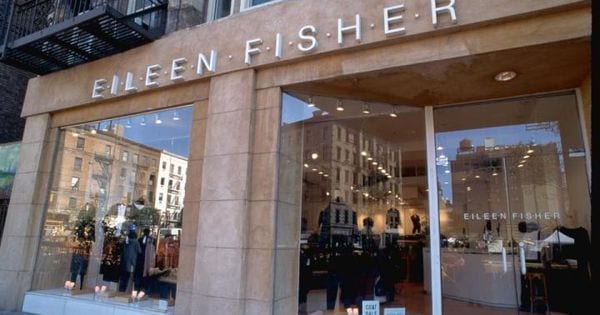Eileen Fisher, AYR and Patagonia Take Fashion Green
Getty: Eileen Fisher Storefront
I’ve talked a lot about fast-fashion trends in past articles. In some ways, it seems like the best way for retailers and brands to compete and win over the consumer whose preferences are constantly changing.
However, the fast-fashion model is increasingly scrutinized for creating a lot of waste. It’s a big problem. In 2019, Americans will throw away more than 35 billion pounds of textiles, according to the Council for Textile Recycling. That’s nearly double the amount from 1999.
Additionally, a new report says the manufacturing of apparel and textiles emits more greenhouse gasses than global aviation and shipping combined, making it the world’s number two polluter.
Low quality clothes and gasses are not the only thing to blame. Retailers’ and brands’ obscure strategies for getting rid of products they don’t need have been in the news lately. British luxury fashion brand Burberry was called out earlier this year for burning more than $37.6 million of its stock. The company admitted to destroying the products instead of selling it off cheaply, to protect the brand’s exclusivity and value. It’s worth noting that Burberry is not alone in this practice, it’s common among luxury brands, and they’ve since abandoned the tactic.
Some retailers and brands are paving the way for a greener approach to fashion. Let’s walk through some of their strategies.
Slow Fashion
Increasingly we’re seeing designers push back against the pressure to deliver new products at an ever-faster rate. The idea of slow fashion is about buying less clothing, and retailers and brands focusing on timeless designs that can be worn more than once and won’t go out of style.
Less is more with slow fashion. Brands like Elizabeth Suzann have embraced seasonless basics and in doing so maintained their ability to provide quality workmanship with items handmade in Nashville. Another example is AYR, whose name stands for “All Year Round.” The company specializes in made-to-last luxe basics like cashmere sweaters and high-end jeans.
As these brands continue to emerge, it will be interesting to see if their appeal expands beyond eco-conscious consumers.
Repurposed Fashion
One of the most prominent examples of the repurposed fashion strategy is Eileen Fisher’s Renew brand. The concept is simple. Eileen Fisher buys back its old clothes and gives the customer a $5 reward card. The company then donates the clothing or turns the items into one-of-a-kind designs sold under the Renew label. The concept is obviously growing in popularity as the company bought back its millionth garment in May.
Patagonia has a similar program called Worn Wear that it started in 2005. With the program shoppers can sell their used Patagonia items in good condition back to the company and buy pre-owned products at discounted prices.
Smarter Fashion
Another way that retailers and brands are able to minimize waste is simply by making data-backed decisions. Forward-looking Voice of the Customer technology is better at predicting winning and losing products than intuition or historical data alone.
Retailers and brands leveraging this technology are able to better gauge the amount of inventory that should be created for each product. This greater accuracy also allows them to avoid investing in developing products that will never make it to the store shelf.
Kohl’s is a good example of a company that is successfully leveraging technology and data to take a less-is-more approach. The company’s test-read-and react product strategy gives it a leg up on product selection and speed to market.
Additionally, by coupling Voice of the Customer technology with 3D CADs, retailers and brands can completely avoid creating physical samples or small production runs for in-store testing only to have them fail. This technology allows companies to test at various times throughout the product development process, and retailers and brands get results in a few days rather than a few months.
As another benefit, this technology can provide an in-depth look at what demand looks like at various price points. With that understanding, brands and retailers would be able to ensure their products are priced where they can sell the highest amount at full price, avoiding markdowns, margin erosion, and negative press about their environmental impact.
No matter what approach retailers and brands take to go green, they still need to provide their customers with the products they want at the right time and price. The most successful eco-conscious brands will remember to keep the customer’s wants and needs top of mind.
Let’s block ads! (Why?)

